Timber Recovery and Conversion
Sawing
For most milling operations, processing starts in the forest. Once the tree is felled, the crown is removed. The crown consists of the upper branches and most of the leaves. These are often left in the forest as a source of humus for the forest floor and to act as mulch. The larger branches may be removed and chipped for the pulp and paper industries.
Timber from saw logs
The logs are sent to a saw mill for conversion to sawn timber and sawn timber products. Again, there are very many different ways of handling timber in saw mills, but the steps outlined here are the most common ones:
- Logs are stockpiled under water sprays to prevent them from splitting as they rapidly dry out.
- The logs are then sawn into rectangular shapes in the “green mill”. Here the logs are fully saturated and the saws leave a rough surface on the wood, as some of the fibres are torn out rather than cut.
- For seasoned timber products, seasoning or drying of the rectangular sections takes place. This is removal of much of the moisture from inside the timber.
- Seasoned products are then machined to give smooth or shaped surfaces.
- All sawn products are graded, which entails characterising the likely performance of the timber and stamping each piece so that it can be identified in a sale yard or on a job site as having a given grade.
Conversion 1 – Log breakdown
Logs are pretty difficult to handle because of their cylindrical shape, so the first steps in a normal saw mill operation involves cutting the logs to provide flat surfaces. There are many different cutting patterns used to produce timber – the following are two examples:
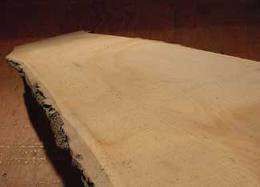 Splits – The first saw cut is through the centre of the log to give two splits, each of which has a flat face for registering in further cutting operations. A characteristic of splits is that the pith is always on or close to one edge of each of the splits. Some timber cut using this pattern will have the pith on or
Splits – The first saw cut is through the centre of the log to give two splits, each of which has a flat face for registering in further cutting operations. A characteristic of splits is that the pith is always on or close to one edge of each of the splits. Some timber cut using this pattern will have the pith on or
near an edge.
Flitch – A large piece of log, sawn on at least two surfaces, intended for further cutting.
The first saw cuts go either side of the heartwood in the very centre of the log. The pieces that are left on the outside are called wings, and the almost- rectangular piece from the centre is called a flitch.
Conversion 2 – green sawn
Once some flat surfaces have been established by the breakdown saw, the other saws in the green mill can cut the various pieces into marketable timber. Each mill establishes its own cutting patterns for different sized logs, in an attempt to maximise the number of pieces cut in the most popular sizes.
Types of Cuts
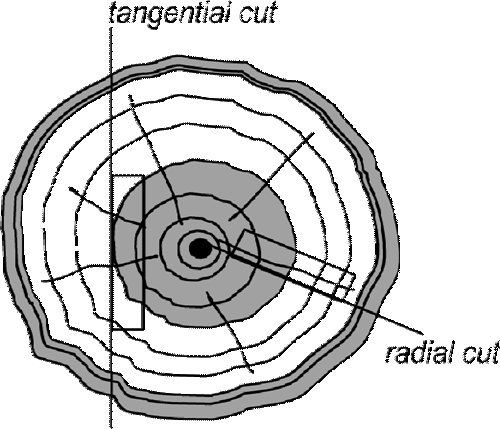
Radial Cut
Tangential Cut
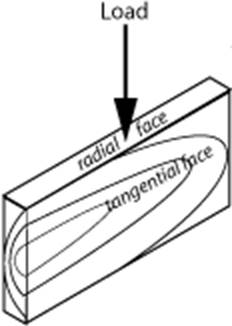 A cut made which is tangential to the growth rings.
A cut made which is tangential to the growth rings.
They are stronger when placed correctly edge up and are used for beams and joists
This type of board suffers from 'cupping' if not carefully converted, seasoned, and stored properly. Annual growth
rings form an angle less than 45 degrees.
Timber sawn on the radius from the central axis of the tree or log to the circumference, perpendicular to the growth rings.
Less cupping than tangential sawn timber
Sawing patterns
The following describes a number of different cutting patterns. Each cutting pattern produces timber with a distinct appearance and character. If a particular cutting pattern is specified (eg quarter sawn), it may require longer lead times to fill an order if current stocks do not comply with the designated cutting pattern. It can be useful with appearance products to specify that the majority of timber products supplied should be of a particular pattern. Each type has its advantages and disadvantages.
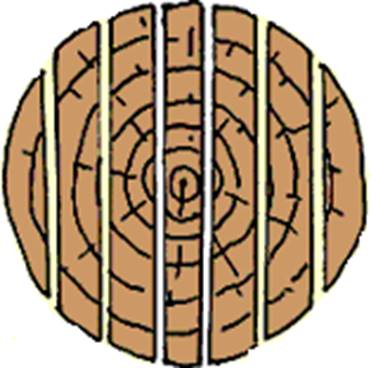 Live sawing
Live sawing
- The logs are cut into boards by a series of parallel saw cuts.
- In large mills gang saws (similar to a large jig saw with several blades) are used.
- Commonly used in Australia for plantation grown Radiata Pine.
Advantages
- Simplest and most economical method; there is very
little waste and the logs do not have to be turned and returned for re-cutting
- Suitable for rapid mass production of boards for standard lines such as framing material.
Disadvantages
- The timber may warp or shrink unevenly
Back sawn timber
Unless specified otherwise, most structural timber and many appearance products are currently backsawn or close to backsawn. Backsawn timber is characterised by:
 The long face of each board is close to a tangential face, and the short face is close to a radial face.
The long face of each board is close to a tangential face, and the short face is close to a radial face. - Growth rings parallel to long edge. The wide face does not intersect many growth rings. The growth rings on the wide face appear to be very wide apart, and some interesting patterns can be seen.
- This cut offers more flexibility in that quite large boards can be backsawn from the wings of logs. Here the maximum depth can be just less than the diameter of the log.
Advantages:
- seasons more rapidly
- good figure on face
- less prone to splitting when nailing
- wide sections possible
- few knots on edge
Disadvantages:
- shrink more across width when drying
- more likely to warp and cup
- collapsed timber more difficult to recondition
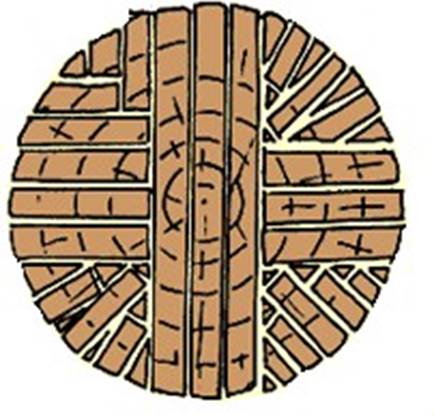 Quarter sawn timber
Quarter sawn timber
- Growth rings are parallel to the short face. The long face of every board is close to a radial face. A large number of growth rings can be seen on this face.
- If they are to be quarter sawn very large logs are required, as the maximum depth of board is less than the radius of the log.
Advantages
- best grain shows on face
- good wearing surface for floors, furniture
- radial face preferred for coatings
- lower width shrinkage on drying
- less cupping and warp than other cuts
- can be successfully reconditioned
Disadvantages:
- slower seasoning
- nailing on face more prone to splitting